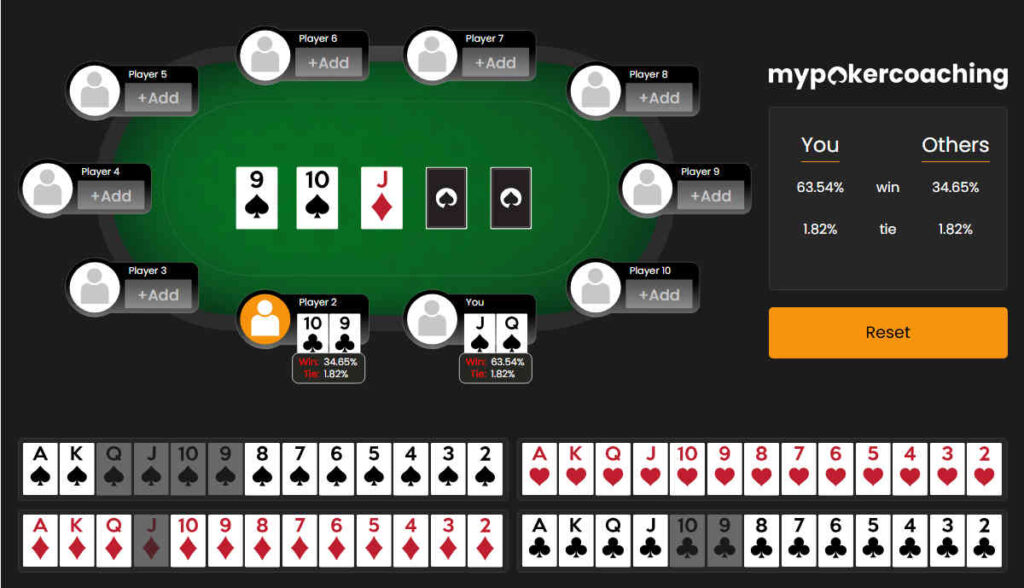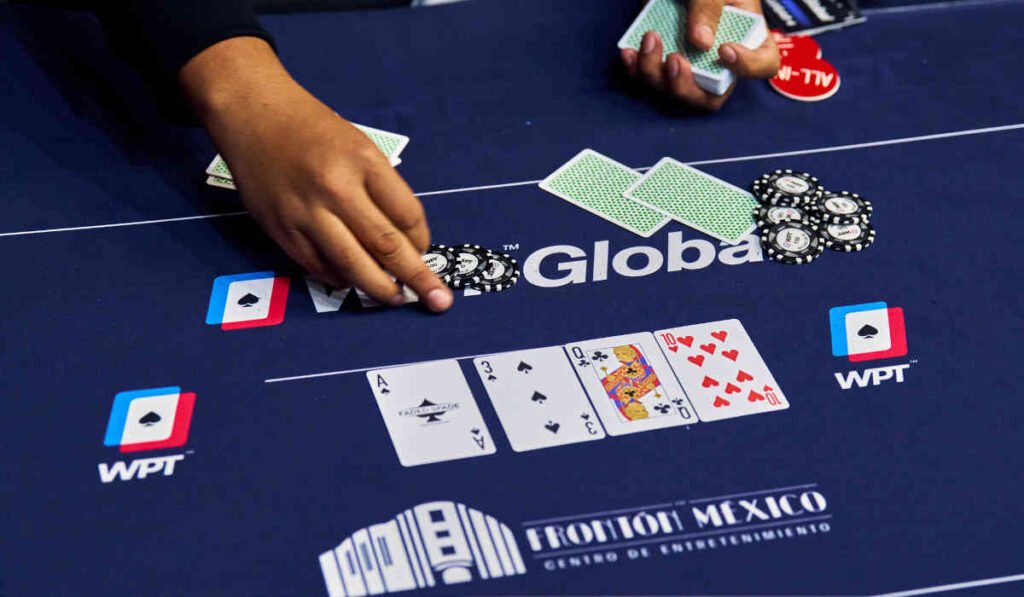Whether you go to play poker at your local casino or watch a poker stream on YouTube, you will hear players talking about their outs and their odds.
Indeed, poker outs are a critical concept, but one that takes some adjusting to when you are just learning the game.
If you don’t know what poker outs are and how they work in practice, we are going to teach you and help you use this concept in your future games.
Let’s start out with the most basic explanation of what poker outs are, and go from there.
What Are Outs in Poker?
In the simplest of terms, poker outs are cards that can help a player improve their drawing poker hand into a made poker hand.
For example, on a board of A♠9♠4♠, a player may hold K♠Q♠ for a flush draw. In this case, any card with a spade symbol on it can be considered their out.
Since there is a total of 13 spades in the deck, with four of them accounted for, the player has nine outs to make a flush.
This same concept of poker outs can be applied in other Texas Hold’em scenarios as well, whether a player has a drawing hand or a made hand that needs to improve.
For example, imagine going all-in on a flop of J♠9♣7♥ with your K♠J♠, only to get called by a pair of queens.
Your top pair is in trouble and needs to improve in order to win. However, with two cards to come, you have some poker outs that can help you.
In this particular scenario, any remaining Jack or King can turn your hand into two pair or trips. There are three Kings remaining in the deck, along with two Jacks, which means you have five outs to make your hand and win the pot.
Counting Outs in Poker
Counting outs is one of the most basic, and fortunately easiest, strategic processes in all of poker. Like the term implies, it’s quite literally all about simple counting.
In order to count outs efficiently, keep in mind that there are exactly 13 cards of every suit and four cards of every ranking in the deck, for a grand total of 52.
So, how do you count outs based on this? Let’s look at an example!
On a board of J♦10♠9♠, you hold Q♠J♠. Assuming your hand needs to improve to win the pot, let’s take a look at all the poker outs you have to improve:
- Nine Spades to improve to a flush or straight flush (2♠, 3♠, 4♠, 5♠, 6♠, 7♠, 8♠, K♠, A♠)
- Three Kings to improve to a straight (K♥, K♦, K♣)
- Three Eights to improve to a straight (8♥, 8♦, 8♣)
- Two Jacks to improve to trips (J♥, J♣)
- Three Queens to improve to two pair (Q♥, Q♦, Q♣)
In total, that’s 20 outs that can help you improve your hand and potentially win against a hand like T9 that already has two pair.
Of course, depending on what you are up against, some of these outs may not work for you, as your opponent could already have a set or a straight.
When counting your outs, you should think about the possible hands your opponent can have and count your possible outs against the different poker combinations you may be up against.
Using Poker Outs to Calculate Your Odds
Of course, simply knowing how many outs you have doesn’t really help too much. You know which cards can help you, but how do you determine what the odds are of those cards coming on the turn or river?
Well, you could use some very basic math to calculate whether you play online poker cash games, tournaments, or in a live environment. In the previous example, your hand has 20 outs to improve. We know there is a total of 52 cards in the deck, and five of them are accounted for, leaving you with 47 cards.
This means that 20 out of the 47 cards can improve your hand, and two more cards are going to be dealt.
That means there is about 42% chance of one of our cards hitting on the turn, and just as much of it hitting on the river, giving us a very reasonable chance to improve our hand.

Of course, it is also worth noting that our opponent can hit a T or a 9 to make a full house, if they do hold T9, or other cards if they have different card combinations.
In either case, once you know the number of outs you are working with, you can calculate your odds in a hand in several ways.
The most convenient way is to use a poker odds calculator, which takes into account all the potential outcomes and future cards to give you the most accurate odds for each hand to win.
Yet, if you don’t have an odds calculator handy, or you are playing in a game and aren’t allowed to use one, there is a simple way to calculate your odds on the fly based on poker outs.
Using the Rule of Two and Four to Calculate Odds
To calculate your drawing odds based on your outs count, all you need to do is learn the rule of two and four and how to apply it.
This rule is very simple! If you are calculating your odds on the flop, multiply the number of outs by 4. If you are calculating your odds on the turn, multiply the number of outs by 2.
For example, imagine you are drawing to a flush, and you have 9 outs to improve. By the rule of 4 and 2, you would have a 36% (9×4) chance to improve from the flop, and an 18% (9×2) chance to improve from the turn.
The actual calculation tells us that the odds are 35% on the flop and 19.6% on the turn, which puts our numbers quite close with minimal math required.
Keep in mind that the quick calculations done using the rule of 2 and 4 will never be 100% accurate, but they will be close enough to give you the info you need to make in-game decisions.
Calculating Odds for Higher Out Counts
As you will see in the table below, the calculations made using the rule of two and four start to deviate more from the actual poker odds as the out count gets higher.
For example, the flop calculation for 9 outs gives us odds of 36%, which is close to the actual 35%. Yet the flop calculation for 16 outs gives us 64%, while the actual odds are 57%, which is a significant deviation.
There is a solution to this problem. While it’s also not perfect, it can help you get a fairly accurate calculation on the fly.
Once the number of outs starts to grow over nine, use the following formula:
- Equity = (Outs x 4) – (Outs – 8)
- Equity = (16×4) – (16 – 8)
- Equity = 64 – 8
- Equity = 58%
As you can see, the calculation now produced the number 58, which is much closer to the actual 57% equity you have.
Keep in mind that this calculation only works for the flop, while the turn odds will not be affected as badly.
You can do some basic comparisons in the table below and see how odds change going from flop to turn for different common out counts.
Outs and Odds in Different Poker Scenarios
How that we have explained how poker outs work and how you can use them to calculate your odds of winning a pot, let’s take a look at some common scenarios you will come across in poker.
This table contains the outs count, as well as the flop and turn odds you have of improving with them in Texas Hold’em Poker:
| Draw | Number of Outs | Flop Odds | Turn Odds |
| Pair to Set | 2 | 8.4% | 4.3% |
| One Overcard | 3 | 12.5% | 6.5% |
| Gutshot Straight Draw | 4 | 16.5% | 8.7% |
| Pair to Two Pair or Trips | 5 | 20.3% | 10.9% |
| Two Overcards | 6 | 24.1% | 13% |
| Set to Full House/Quads | 7 | 27.8% | 15.2% |
| Open Ended Straight Draw (OESD) | 8 | 31.5% | 17.4% |
| Flush Draw | 9 | 35% | 19.6% |
| OESD + Overcard | 11 | 41.7% | 23.9% |
| Flush Draw + Overcard | 12 | 45% | 26.1% |
| OESD + 2 Overcards | 14 | 51.2% | 30.4% |
| Open Ended Straight Flush Draw (OESFD) | 15 | 54.1% | 32.6% |
| OESFD + Overcard | 18 | 62.4% | 39.13% |
| OESFD + 2 Overcards | 21 | 69.94% | 45.65% |
Poker Outs in Practice – Dirty Outs and Backdoor Draws
Of course, not every situation in poker is the same. The sheer outs count won’t always be enough to define your equity in a hand and determine how your hand does against your opponent’s.
For starters, you don’t get to see your opponent’s cards when you are thinking about your outs. For that reason, you won’t always know exactly which outs to count and which to discount.
In our earlier example, we counted a total of 20 outs with our open-ended straight flush draw, a pair, and an overcard.
Yet, not all of those 20 outs are going to be good against all of our opponents’ hands. For example, if our opponent already has a straight, our outs to trips and two pair won’t help us win the hand.
These cards, which may help improve our hand, but not necessarily the best hand, are called dirty outs.
If you are considering making a big call and you are counting your outs, you should remember not to take your dirty outs into full consideration. In some cases, you may want to discount them altogether.
Conversely, there will be situations in which you have “backdoor draws.” These are draws that still require two cards to improve, but they can also add some equity to your hand.

For example, on a board of 8♠7♠5♣, you may have a hand like A♠10♦. This hand doesn’t have any direct draws, but it does have some backdoor options.
The Ace of Spades in your hand gives you a chance to make a flush with two Spades, while the Ten allows you to make a straight in two different ways by the river.
Whenever the equities are close, backdoor draws can be the deciding factor between making a profitable call or not.
Practice Counting Outs and Memorize the Tables
Before you play your next poker session, take some time to practice using the rule of two and four and memorize as many of the odds calculations as you can from the table above.
These two methods will allow you to know at least your approximate odds in every common situation in poker.
With the knowledge of poker outs and odds, you can make the right calls, choose the right poker hands to bluff with, and get an upper hand over your less competent and focused players. Remember, poker is ultimately a game of math, and knowing these numbers is the first big step towards understanding the game on a deeper and more accurate level.


